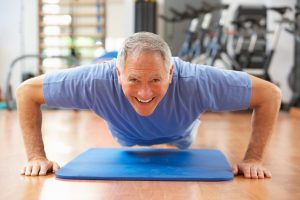Last week’s column focused on the benefits of exercise vis-à-vis high blood pressure, high cholesterol and cancer. This third and final segment of Doctors Ditching Drugs will discuss Metabolic Syndrome, lower back pain and osteoporosis.

Metabolic Syndrome
Exercising is very helpful in weight reduction and in preventing weight gain. It is also beneficial in maintaining a healthy weight after a successful weight loss program. Therefore, the strongest predictor of successful, permanent weight loss is a well-rounded exercise program.
Being overweight is known to bring on many health-related complications including Metabolic Syndrome, otherwise know and Syndrome X. Syndrome X has been called the deadly quartet as well as insulin resistance syndrome and is responsible for both diabetes and cardiovascular disease.
Metabolic Syndrome is comprised of a perilous collection of risk factors, or cluster of metabolic disorders which, individually or as a group, promote the development of diabetes and atherosclerosis. The root causes of this syndrome are overweight/obesity, physical inactivity and genetic factors.
Lower Back Pain
Lower back pain (LBP) levies a heavy toll upon men and women alike. Roughly 70% of all people will experience one bout of lower back pain in their lifetime, with many experiencing repeated bouts or even chronic back pain. Although we are all tempted to take anti-inflammatory or muscle relaxants, exercise can both prevent, help or completely cure LBP.
LBP typically is located in the lumbar region of the spine, with L4 and L5 being the most commonplace. Undoubtedly, you have probably heard of slipped, herniated, shattered, protruding and crushed disks – all of which are manifestations of LBP. What brings on these conditions, and how can they be corrected, and possibly even prevented, in the first place?
The main causes of LBP are weak abdominal muscles, tight hamstring muscles, poor posture and stress. Many times, LBP is the result of a biomechanical dysfunction resulting from flat feet, and often can be corrected with a pair of good, functional orthotics.
Also, a simple thing like a worn-out pair of shoes can bring on back discomfort. Prevention of LBP includes a well-balanced exercise program which encompasses flexibility training (stretching) and abdominal strengthening. And aerobic exercise is known, amongst its many benefits, to be a great stress-reducer. Being overweight is also a risk factor, as is smoking.
Many years ago, the common approach to treating LBP was to prescribe bedrest. Strong evidence now indicates that this treatment is ineffective. Studies have shown that bedrest of more than 2-4 days can cause muscles to begin to weaken, and can actually delay recovery. The current thinking is that a person with LBP should be physically active. Walking, even if it is somewhat painful, is considered essential.
Osteoporosis
It’s silent, it’s progressive and it can disable. Two-hundred million people worldwide have it. Women develop it four times as often as men do. And the older you are, the greater the risk of developing it. We’re talking about osteoporosis.
Bone is a complex living tissue. It provides structural support for muscles, protects vital organs and stores calcium, which is essential for bone density and strength. Bone is constantly “remodeling,” meaning that old bone is broken down and new bone is deposited.
At about age 45-50, more old bone is broken down than is replaced. This process is accelerated in menopausal women as they lose the protection that estrogen had given them previously. The earlier a woman experiences menopause, the greater the risk of osteoporosis. The best strategy for preventing osteoporosis is to build strong bones, especially before the age of 35. This will reduce bone loss later in life.
Both strength training (weights) and weight-bearing aerobic exercise (brisk walking, jogging, skipping rope or running) are essential to prevent osteoporosis and help reduce further bone loss in those who already have the disease. The strength training is essential for the bones in the upper body while the weight-bearing exercises are necessary for the bones in the lower extremities.
In Conclusion
We haven’t yet found the magic pill cure-all. But the closest thing we have to it is a good, well-rounded exercise program. Whether it is to prevent, cure or improve any of the many diseases and illnesses to which we are all potentially subject, or to reduce our stress and feel better about life, exercise is a MUST for everyone, no matter your age, gender or weight. Have your doctor include exercise in his/her prescription for almost anything that may bother you. Take the important mitzvah (commandment) of “v’nishmartem me’od l’nafshoseichem (you shall surely guard your soul)” seriously by exercising regularly.
Alan Freishtat is an A.C.E. CERTIFIED PERSONAL TRAINER and a BEHAVIORAL CHANGE and WELLNESS COACH with over 19 years of professional experience. Alan is the creator and director of the “10 Weeks to Health” program for weight loss. He is available for private coaching sessions, consultations, assessments and personalized workout programs both in his office and by telephone and skype. Alan also lectures and gives seminars and workshops. He can be reached at 02-651-8502 or 050-555-7175, or by email at alan@alanfitness.com Check out the his web site –www.alanfitness.com US Line: 516-568-5027.
The words of this author reflect his/her own opinions and do not necessarily represent the official position of the Orthodox Union.

